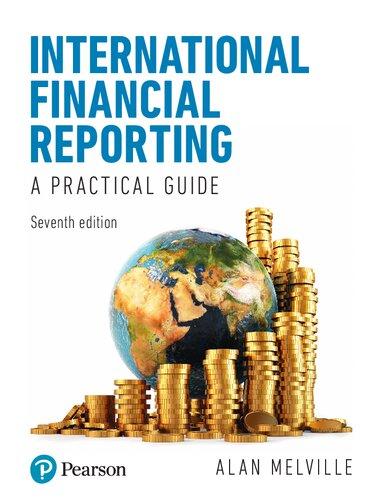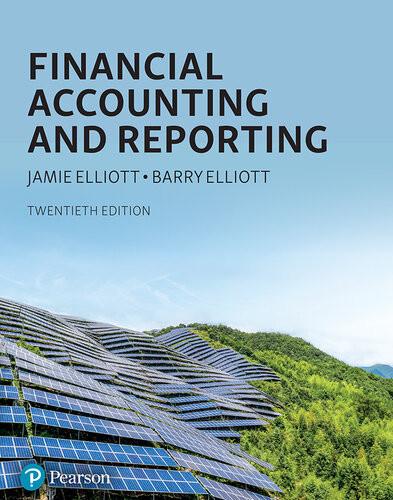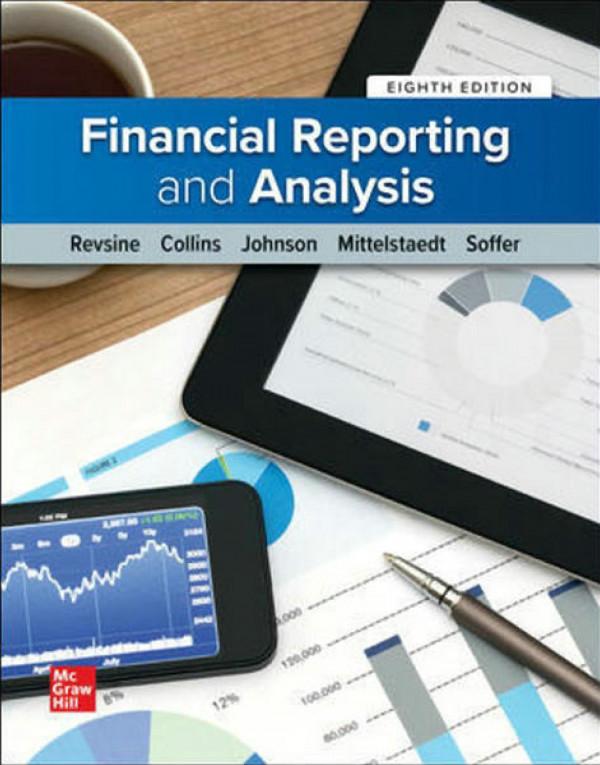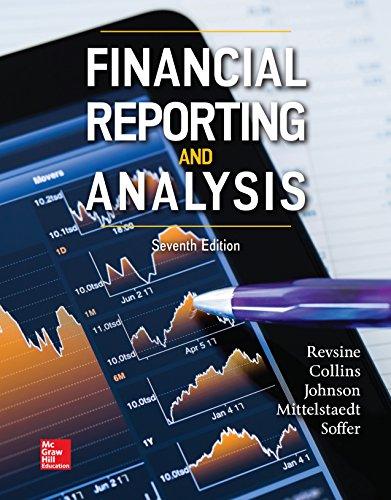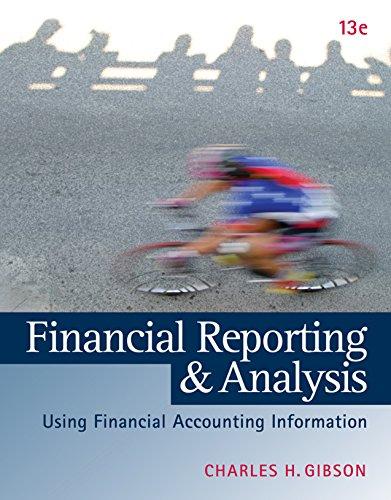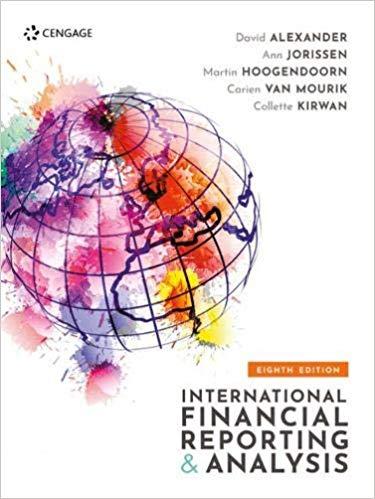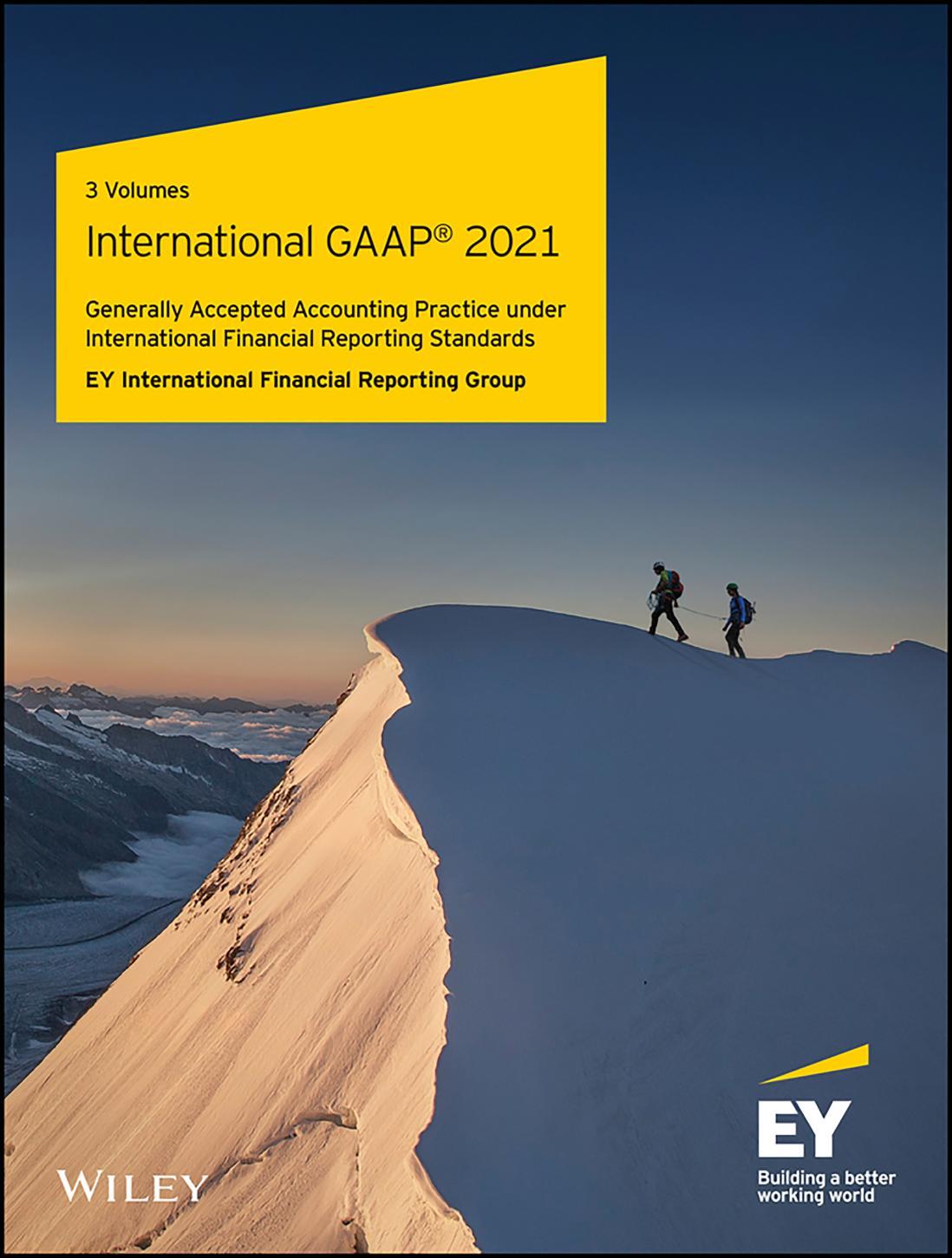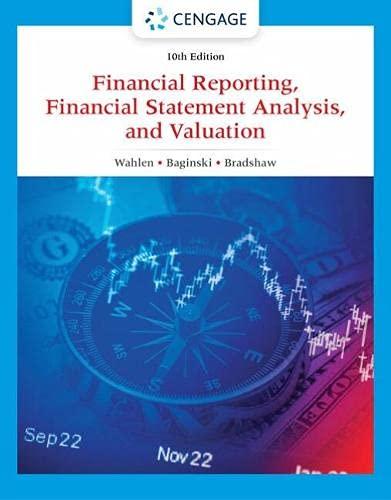CONTENTS
CHAPTER1
Accountingregulationand the C onceptual Framework 1
1.1Keysourcesofregulationoffinancial reportingin Australia2
1.1.1TheCorporationsAct2
1.1.2Australianaccounting standards4
1.1.3Aconceptualframework8
1.1.4AustralianSecuritiesExchange ListingRules9
1.2Therolesofkeyplayersinfinancial r eportingr egulation10
1.2.1FinancialReportingCouncil (FRC)11
1.2.2Australian AccountingStandards Board(AASB)12
1.2.3AustralianSecuritiesandInvestments Commission(ASIC)15
1.2.4AustralianPrudentialRegulation Authority(APRA)16
1.2.5AustralianSecuritiesExchange Group(ASX)16
1.3TheInternationalAccounting StandardsBoar d(IASB)17
1.4Thecomponentsofthe Conceptual Framework 17
1.4.1Theobjectiveoffinancial reporting18
1.5 Qualitativecharacteristicsofuseful information19
1.5.1Fundamental qualitative characteristics19
1.5.2Enhancing qualitative characteristics20
1.5.3Costconstraintonusefulfinancial reporting21
1.6Financialstatementsandthereporting entity22
1.6.1Going concernassumption22
1.6.2Ther eportingentity23
1.7Definitionoftheelementsoffinancial statements23
1.7.1Assets 23
1.7.2Liabilities25
1.7.3 Equity26
1.7.4Income26
1.7.5Expenses27
1.8Recognitionandderecognitionofthe elementsoffinancial statements27
1.8.1Recognitioncriteria27
1.8.2Der ecognition 29
CONTENTS
1.9Measurementoftheelementsof financialstatemen ts 30
1.9.1Factorstoconsiderwhenselectinga measurementbasis 31
1.10Presentationanddisclosure32
1.10.1Classification32
1.10.2Aggregation 33
1.11Conceptsofcapital33
1.12Inconsistenciesbetween the ConceptualFramework and accountingstandards34
Summary36
Keyterms36
Compr ehensionquestions37
Casestudy1.138
Casestudy1.238
Casestudy1.338
Casestudy1.438
Applicationandanalysisexercises39 References41 Acknowledgements41
CHAPTER2
Applicationofaccounting the ory42
2.1Professionaljudgementin accounting43
2.2What isanaccountingpolicy?44
2.3Whatisaccountingtheory?45
2.3.1Typesoftheories46
2.3.2Developmentof theories46
2.4Positiveaccountingtheory48
2.4.1Nexusofcontracts49
2.4.2Agencytheory 49
2.4.3Owner–manageragency relationships50
2.4.4Manager–lenderagency relationships53
2.4.5Politicalrelationships54
2.4.6Roleofaccountinginformationin reducingagencyproblems55
2.4.7Implicationsofagencytheoryfor accountingpolicychoice55
2.5Theroleofaccountingincapital markets 57
2.5.1The mechanistichypothesis57
2.5.2Theef ficientmarkethypothesis57
2.5.3Whatdoesaccountingtheorytellus aboutaccountingpolicies?59
Summary60
Keyterms61
Comprehensionquestions61
Casestudy2.162
Casestudy2.262
Casestudy2.363
Applicationandanalysis exercises63 References65
Acknowledgements66
CHAPTER3
Fairvaluemeasurement67
3.1Introductionandscope68
3.2Thedefinition offairvalue69
3.2.1Currentexitprice69
3.2.2Orderly transactions70
3.2.3Marketparticipants70
3.2.4Transactionandtransportcosts70
3.3Applicationtonon-financialassets72
3.3.1Step1.Whatistheparticularasset beingmeasured? 72
3.3.2Step2.Whatistheappropriate measurementvaluationpremise?73
3.3.3Step3.Whatistheprincipal(ormost advantageousmarket)fortheasset?75
3.3.4Step4.Whatistheappropriate valuationtechniqueforthemeasurement oftheasset?76
3.4Applicationtoliabilities82
3.4.1Correspondingassetapproach82
3.4.2Non-performance riskandcredit enhancements84
3.5Applicationtoanentity’sownequity instruments85
3.6Issues relatingtoapplication tofinancialinstruments85
3.6.1Inputsbasedonbidandask prices86
3.6.2Of fsettingpositions86
3.7Disclosurerequirements86
Summary89
Keyterms 89
Comprehensionquestions90
Casestudy3.190
Casestudy3.291
Casestudy3.391
Casestudy3.492
Casestudy3.592
Casestudy3.693
Applicationandanalysisexercises93
Reference96
Acknowledgements96
CHAPTER4
Inventories98
4.1Thenatureofinventories99
4.2Recognitionand measurement ofinventories101
4.3Measurementatcost101
4.3.1Costsofpurchase102
4.3.2Costs of conversion104
4.3.3Othercosts104
4.3.4Estimatingcost106
4.3.5Costofinventoriesofaservice provider107
4.3.6Inventoriesofnot-for-profit entities107
4.4Methodsofrecordkeepingfor inventorycontr ol 108
4.4.1Periodicmethod108
4.4.2Perpetualmethod 109
4.5End-of-periodaccounting112
4.5.1Physicalcount112
4.5.2Cut-off procedures113
4.5.3Goodsintransit113
4.5.4Consignmentinventories114
4.5.5Controlaccount/subsidiaryledger reconciliation114
4.6Assigningcoststoinventories onsale116
4.6.1 First-in,first-out(FIFO)cost formula117
4.6.2W eightedaveragecostformula117
4.6.3Whichcostingmethodtouse?119
4.6.4Consistentapplicationofcosting methods120
4.7Netrealisablevalue120
4.7.1Estimatingnetrealisablevalue121
4.7.2Materialsand othersupplies121
4.7.3Write-downtonetrealisable value121
4.7.4Reversalofpriorwrite-downtonet realisablevalue122
4.8Recognitionasanexpense123
4.9Disclosure124
Summary 126
Keyterms126
Demonstration problems126
Comprehensionquestions129
Casestudy4.1130
Casestudy4.2130
Casestudy4.3130
Casestudy4.4130
Applicationandanalysisexercises131
References139
Acknowledgements139
CHAPTER5
Property,plantand equ ipment140
5.1Thenatureofproperty,plantand equipment141
5.2Initial recognitionofPPE141
5.2.1Thesignificantpartsapproach142
5.3InitialmeasurementofPPE143
5.3.1Purchaseprice143
5.3.2Directly attributablecosts145
5.3.3Acquisitionforzeroornominal cost147
5.3.4Costsofdismantling,removalor restoration147
5.4Measurementsubsequenttoinitial recognition148
5.5 Thecostmodel149
5.5.1Depreciation149
5.6Therevaluationmodel157
5.6.1Revaluationincreasesanddecreases 158
5.6.2Revaluationincr easesanddecreases involvingreversals159
5.6.3Depreciationofrevaluedassets161
5.7Derecognition162
5.8Disclosure 163
Summary166
Keyterms166
Demonstration problem166
Comprehensionquestions169
Casestudy5.1169
Casestudy5.2170
Casestudy5.3170
Casestudy5.4170
Casestudy5.5170
Applicationandanalysisexercises170
Reference181
Acknowledgements181
CHAPTER6
Intangibleassets182
6.1Introductionandscope183
6.2Thenatur eofintangibleassets184
6.2.1Identifiable185
6.2.2Non-monetaryin nature186
6.2.3Lackofphysicalsubstance186
6.3Recognitionofintangibleassets187
6.4Measurement 187
6.4.1Separateacquisition188
6.4.2Acquisitionas partofabusiness combination188
6.4.3Internallygeneratedintangibleassets 189
6.4.4Internallygeneratedgoodwill192
6.4.5Examplesofrecognitionand measurementofintangibleassets192
6.5Amortisationofintangibleassets193
6.5.1Finiteusefullives194
6.5.2Indefiniteuseful lives194
6.6Measurementsubsequenttoinitial recognition197
6.6.1 Subsequentexpenditure198
6.7Disclosure198
Summary201
Keyterms201
Demonstration problem201
Comprehensionquestions203
Casestudy6.1204
Casestudy6.2204
Applicationandanalysisexercises205
CONTENTS
Reference209
Acknowledgements210
CHAPTER7
Impairmentofassets211
7.1Introductionandscope212
7.2Whento undertakeanimpairment test214
7.2.1Evidenceofimpairment214
7.3Theimpairmenttest216
7.3.1Fairvaluelesscostsofdisposal217
7.3.2Value inuse217
7.4Impairmentloss:individualassets218
7.5Impairmentloss: cash-generating units219
7.5.1Identifyingacash-generating unit220
7.5.2Goodwill andCGUs221
7.5.3ImpairmentlossforaCGU222
7.5.4Corporateassets225
7.6Reversalofanimpairmentloss227
7.6.1Individualassets228
7.6.2Cash-generatingunits 228
7.7Disclosure230
Summary234
Keyterms234
Demonstration problems234
Comprehensionquestions238
Casestudy7.1239
Casestudy7.2239
Casestudy7.3240
Casestudy7.4241
Casestudy7.5241
Applicationandanalysisexercises241
References250
Acknowledgements251
CHAPTER8
Provisions,contingent lia bilitiesandcontingent assets252
8.1Introductionandscope253
8.2Definitionof aprovision254
8.2.1Distinguishingprovisionsfromother liabilities255
8.3Definition ofacontingentliability255
8.3.1Distinguishingacontingentliability froma provision256
8.4Therecognitioncriteriafor provisions256
8.4.1 Puttingitalltogether—auseful decisiontree 257
8.5Measurementofprovisions258
8.5.1Bestestimate258
8.5.2Risks and uncertainties259
8.5.3Presentvalue260
8.5.4Future events261
8.5.5Expecteddisposalofassets261
8.5.6Reimbursements261
8.5.7Changesinprovisionsanduseof provisions262
8.6Applicationofthedefinitions, recognitionand measurementrules 263
8.6.1Futureoperatinglosses263
8.6.2Onerous contracts263
8.6.3Restructuringprovisions264
8.6.4Otherapplications269
8.7Contingentassets272
8.8Disclosure 273
8.9ComparisonbetweenAASB3/IFRS3 andAASB137/IAS37inrespectof contingentliabilities276
8.9.1Contingentliabilitiesacquiredina businesscombination276
8.9.2 Contingentconsiderationina businesscombination276
Summary278
Keyterms278
Demonstrationproblem278
Comprehensionquestions282
Casestudy8.1283
Casestudy8.2283
Casestudy8.3283
Applicationandanalysisexercises283
Reference288
Acknowledgements288
CHAPTER9
Employeebenefits289
9.1Introductiontoaccountingforemployee benefits290
9.2Short-term employeebenefits290
9.2.1Payroll291
9.2.2Accountingf orthepayroll291
9.2.3Accrualofwagesandsalaries293
9.2.4Short-termpaidabsences293
9.2.5Profit-sharingandbonusplans296
9.3Post-employmentbenefits297
9.4 Accountingfor definedcontribution post-employmentplans299
9.5Accountingfordefinedbenefit post-employmentplans301
9.5.1Step1.Determinethedeficitor surplusofthe fund302
9.5.2Step2.Determinetheamountofthe netdefinedbenefitliability(asset)305
9.5.3Step3.Determinetheamountstobe recognisedinprofitorloss305
9.5.4Step4.Determinethe remeasurementsofthenetdefined benefitliability(asset)toberecognisedin othercomprehensiveincome307
9.6Otherlong-termemployment benefits311
9.7T erminationbenefits315 Summary317 Keyterms317 Demonstration problem318
Comprehensionquestions319
Casestudy9.1320
Casestudy9.2320
Casestudy9.3320
Casestudy9.4320
Applicationandanalysisexercises321 Reference327
Acknowledgements328
CHAPTER10
Leases329
10.1Introductionandscope330
10.1.1Whatisalease?330
10.2Accountingforleasesbylessees333
10.2.1Initialrecognition333
10.2.2Subsequentmeasur ement335
10.2.3Accountingforexecutorycosts 335
10.3Classifyingleasesbylessor339
10.3.1Classificationguidance340
10.3.2Furtherclassification offinance leasesbylessor342
10.4Accountingforfinanceleasesbyfinancier lessors343
10.4.1Initial recognition343
10.4.2Subsequentmeasur ement343
10.5Accountingforfinanceleasesby manufactureror dealerlessors346
10.5.1Initialrecognition346
10.5.2Subsequentmeasur ement347
10.6Accountingforoperatingleasesby lessors348
10.6.1Lease receipts348
10.6.2Initialdir ectcosts348
10.6.3Depreciationofunderlyingassets 348
10.7Disclosurerequirements350
10.7.1Disclosuresrequiredby lessees350
10.7.2Disclosur esrequiredby lessors350
Summary352
Keyterms352
Demonstrationproblems353 Comprehensionquestions361
Casestudy10.1361
Casestudy10.2362
Applicationandanalysisexercises362
Acknowledgements370
CHAPTER11
Financialinstruments371
11.1Introductiontofinancial instruments372
11.1.1T ransactionsthatresultinfinancial instruments372
11.1.2T ransactionsthatdonotresultin financialinstruments372
11.2Financialassets373
11.3Financialliabilities 374
11.4Derivativeinstruments376
11.4.1Hybridcontractswithembedded derivatives377
11.5What isanequityinstrument?378
11.6Distinguishingbetween financial liabilitiesandequityinstruments378
11.6.1Ordinarysharesandpreference shares379
11.6.2 Contingentsettlement provisions380
11.6.3Contractsinvolvingacompany’s ownequityinstruments381
11.7Compoundfinancialinstruments— convertiblenotes382
11.8 Consequentialeffectsof classificationsforinterest,dividends, gainsandlosses384
11.9Recognitionoffinancialassetor financialliability385
11.9.1Subjecttocontractual provisions385
11.9.2 Recognitionofregularway purchasesorsalesofafinancial asset385
11.10Offsettingafinancialassetanda financialliability387
11.11 Derecognitionofafinancialassetora financialliability388
11.11.1Derecognitionoffinancial asset388
11.11.2Der ecognitionoffinancial liability388
11.12Initialmeasurementofafinancialasset orafinancial liability390
11.12.1Initialmeasurementofafinancial asset390
11.12.2Initial measurementofafinancial liability391
11.13Subsequentmeasurementofafinancialasset392
11.13.1 Summaryofrequirements392
11.13.2Measurement offinancialassetsat amortisedcost393
11.13.3Measurementoffinancialassetsat fairvalue395
11.13.4Reclassificationoffinancial assets397
11.14Impairmentoffinancialassets398
11.15Subsequentmeasur ementofa financialliability399
11.15.1Summaryofrequirements399
11.15.2Measurement offinancialliabilities atamortisedcost400
11.15.3Measurementoffinancialliabilities atfairvalue401
11.16Disclosures403
11.16.1Significanceoffinancialinstruments tofinancialposition/performance 403
11.16.2Risksarisingfromfinancial instrumentsandtheirmanagement406
Summary408
Keyterms409
Demonstrationproblems410
Comprehensionquestions413
Casestudy11.1414
Casestudy11.2414
Applicationandanalysisexercises415
References420 Acknowledgements420
CHAPTER12 Incometaxes421
12.1Introductionandscope422
12.2Differ encesbetweenaccountingprofit andtaxableprofit424
12.3Currentandfuturetaxconsequences oftransactionsandotherevents425
12.4Calculationandrecognitionof currenttax426
12.4.1Taxlosses431
12.5Calculationandrecognitionof deferredtax 434
12.5.1Step1.Determinethecarrying amounts435
12.5.2Step 2.Determinethetax bases435
12.5.3Step3.Determineandclassifythe temporarydifferences440
12.5.4Step4(a).Determinetheclosing balancesofdeferredtaxassetand deferredtaxliabilityaccounts442
12.5.5Step4(b).Determinetheadjustments indeferredtaxassetanddeferredtax liabilityaccounts443
12.5.6Step4(c).Preparethedeferredtax adjustmententry443
12.5.7Recognitioncriteriafordeferredtax assetsandliabilities444
12.5.8Othermovementsindeferredtax accountsinthecurrentperiod445
12.5.9Offsettingtaxassetsand liabilities446
12.6Changesintaxrates447
12.7Disclosur e requirements448 viii CONTENTS
Summary452
Keyterms 452
Demonstrationproblem453
Comprehensionquestions457
Casestudy12.1458
Casestudy12.2458
Casestudy12.3458
Casestudy12.4459
Casestudy12.5459
Casestudy12.6459
Applicationandanalysisexercises459
Reference472
Acknowledgements472
CHAPTER13
Sharecapitaland res erves473
13.1Equity474
13.2Types ofcompanies475
13.2.1Not-for-profitcompanies475
13.2.2For-pr ofitcompanies475
13.3Keyfeaturesofthecorporate structure477
13.3.1 Theuseofsharecapital477
13.3.2Limitedl iability478
13.3.3Parvalueandno-parvalue shares478
13.4Differentformsofsharecapital479
13.4.1Ordinaryshares479
13.4.2Prefer enceshares480
13.5Contributedequity:issueofshare capital481
13.5.1Issue ofshares482
13.5.2Oversubscriptions 485
13.6Contributedequity:subsequent movementsinshar ecapital487
13.6.1Placementsofshares488
13.6.2Rightsissues 489
13.6.3Sharepurchaseplans492
13.6.4Dividendreinvestmentplans492
13.6.5Options493
13.6.6Bonusissues495
13.6.7CapitalraisinginAustralia495
13.7Sharecapital:sharebuybacks497
13.7.1Treasuryshares498
13.8Reserves499
13.8.1Retainedearnings500
13.8.2Othercompo nentsofequity501
13.9Disclosure503
13.9.1Specificdisclosures504
13.9.2Statementof changesin equity504 Summary508 Keyterms508
Demonstrationproblems509 Comprehensionquestions513 Casestudy13.1514
Casestudy13.2514
Casestudy13.3515
Applicationandanalysisexercises516 References523 Acknowledgements523
CHAPTER14
Share-basedpayment524
14.1Share-basedpaymenttransactions525
14.2Cash-settledand equity-settledsharebasedpaymenttransactions527
14.3Recognition528
14.4Equity-settledshare-basedpayment transactions529
14.4.1Transactionsinwhichservicesare received529
14.4.2 Transactionsmeasuredbyreference tothefairvalueoftheequityinstruments granted531
14.5Vesting532
14.5.1Treatmentofvesting conditions532
14.5.2T reatmentofnon-vesting conditions536
14.6Treatmentofareloadfeature536
14.7Modificationsto termsandconditions onwhichequityinstrumentswere granted539
14.7.1Repurchases539
14.8Cash-settledshare-basedpayment transactions541
14.8.1Shar e-basedpaymenttransactions withcashalter natives542
14.9Disclosure546
Summary549
Keyterms549
Demonstration problems549
Comprehensionquestions553
Casestudy14.1554
Casestudy14.2554
Casestudy14.3554
Applicationandanalysisexercises554 Reference557
Acknowledgements557
CHAPTER15
Revenue558
15.1ThescopeofAASB15/IFRS15559
15.2Thedefinitions ofincomeand revenue559
15.2.1Income559
15.2.2Revenue560
15.2.3 Ordinaryactivitiesandgrossinflows 560
15.3Thestepsinrecognisingrevenue561
15.3.1Step1.Identifythecontractor contractswith the customer561
15.3.2Step2.Identifytheperformance obligationsinthe contract562
15.3.3Step3.Determinethetransaction price563
15.3.4Step4.Allocatethetransactionprice totheperformanceobligation565
15.3.5Step5.Recogniserevenuewhen (oras)theentitysatisfiesaperformance obligation567
15.4Therecognitioncriteria567
15.4.1Therecognitioncriteriaforincome generally567
15.4.2Sale ofgoods569
15.4.3Renderingofservices571
15.5Revenuerecognitionissuesinvarious industriesinpractice 575
15.5.1Theprincipal/agentdistinction575
15.5.2Telecommunications 576
15.5.3Retail579
15.5.4Airline579
15.6Disclosurerequirementsof AASB15/IFRS15 580 Summary581
Keyterms581 Demonstration problem581
Comprehensionquestions582
Casestudy15.1582
Casestudy15.2583
Casestudy15.3583
Applicationandanalysisexercises583
Reference586
Acknowledgements586
CHAPTER16
Presentationoffinancial
sta tements587
16.1Componentsoffinancial statements588
16.2General featuresoffinancial statements589
16.2.1Fairpresentationandcompliance withstandards 589
16.2.2Goingconcern589
16.2.3Accrualbasisofaccounting590
16.2.4Materialityandaggregation590
16.2.5Offsetting590
16.2.6Frequencyofreporting591
16.2.7Comparativeinformation591
16.2.8Consistencyofpresentation591
16.3Statementoffinancialposition592
16.3.1Statementoffinancialposition classifications592
16.3.2Information requiredtobepresented inthestatementoffinancial position595
16.3.3Informationrequiredtobepresented inthestatementoffinancialpositionorin thenotes596
16.3.4Limitationsofthestatementof financialposition598
16.4Statementofprofitorlossandother comprehensivei ncome598
16.4.1Itemsofcomprehensive income598
16.4.2Information requiredtobepresented inthestatementofprofitorlossandother comprehensiveincome599
16.4.3Informationrequiredtobepresented inthestatementofprofitorlossandother comprehensiveincomeorinthe notes601
16.4.4Illustrativestatementsofprofitorloss andothercomprehensiveincome603
16.5Statementofchangesinequity605
16.5.1Presentationofthestatementof changesinequity 605
16.5.2Informationrequiredtobereportedin thestatementofchangesinequity605
16.6Notes607
16.6.1CompliancewithIFRSsand Australianaccountingstandar ds608
16.6.2Statementofsignificantaccounting policies609
16.6.3Informationaboutcapital611
16.6.4Otherdisclosures611
16.6.5Illustrativeexamplesoffinancial statements612
Summary613
Keyterms613
Demonstrationproblems613 Comprehensionquestions621
Casestudy16.1622
Casestudy16.2622
Casestudy16.3622
Casestudy16.4622
Applicationandanalysisexercises623 References633 Acknowledgements633
CHAPTER17
Statementofcash flow s634
17.1Purposeofastatementofcash flows635
17.2Defining cashandcashequivalents635 17.3Classifyingcashflowactivities637
17.3.1Classifyinginterestanddividends receivedand paid637
17.3.2Classifyingtaxesonincome638
17.4Formatofthestatementofcash flows639
17.4.1Reporting cashflowsfromoperating activities639
17.4.2Reporting cashflowsfrominvesting andfinancingactivities640 x CONTENTS
17.4.3Reportingcashflowsonanet basis641
17.5Pr eparingastatementofcash flows641
17.5.1Cash flowsfromoperating activities643
17.5.2Cash flowsfrominvesting activities648
17.5.3Cashflowsfromfinancing activities649
17.6Otherdisclosures651
17.6.1Componentsofcashandcash equivalents651
17.6.2Changes inownershipinterestsof subsidiariesandotherbusinesses651
17.6.3Non-cashtransactions653
17.6.4Disclosuresthatareencouragedbut notrequired653
Summary655
Keyterms655
Demonstrationproblem655
Comprehensionquestions663
Casestudy17.1664
Casestudy17.2664
Casestudy17.3664
Applicationandanalysisexercises665 Reference675
Acknowledgements675
CHAPTER18
Accountingpoliciesand oth erdisclosures676
18.1Accountingpolicies677
18.1.1Disclosureofaccounting policies677
18.1.2Disclosur eofchangesinaccounting policies683
18.2Changesinaccountingestimates686
18.3Errors 687
18.4Impracticabilityinrespectof retrospectiveadjustmentsfor accountingpolicychangesor correctionoferrors690
18.5Materiality692
18.6Eventsoccurringaftertheendofthe reportingperiod692
Summary695
Keyterms 695
Demonstrationproblems696
Comprehensionquestions698
Casestudy18.1698
Casestudy18.2698
Casestudy18.3698
Casestudy18.4699
Casestudy18.5699
Applicationandanalysisexercises699 References703
Acknowledgements703
CHAPTER19
Earningspershare705
19.1ObjectiveofAASB133/IAS33706
19.2Applicationand scope707
19.3Basicearningspershare708
19.3.1Earnings708
19.3.2Shares 710
19.4Dilutedearningspershare713
19.4.1Earnings714
19.4.2Shares 714
19.5Retrospectiveadjustments718
19.6Disclosure 719
Summary721
Keyterms721
Demonstration problem722
Comprehensionquestions724
Casestudy19.1724
Casestudy19.2724
Casestudy19.3725
Applicationandanalysisexercises725
Reference726
Acknowledgements726
CHAPTER20
Operatingsegments727
20.1Objectivesoffinancialreportingby segments728
20.2Scope 729
20.3Acontroversialstandard729
20.4Operatingsegments730 20.5Reportablesegments733
20.5.1Identifyingreportable segments733
20.5.2Applying thedefinitionofreportable segments736
20.6Disclosure737
20.6.1Generalinformation738
20.6.2Informationabout profitorloss, assetsandliabilities738
20.6.3Measurement739
20.6.4Reconciliations739
20.6.5Entity-widedisclosures740
20.6.6Comparativeinformation740
20.7Applyingthedisclosuresinpractice741
Summary748
Keyterms748
Compr ehensionquestions748
Casestudy20.1749
Casestudy20.2749
Applicationandanalysisexercises749
References753
Acknowledgements753
CHAPTER21 Relatedparty dis closures754
21.1Objective,applicationandscopeof AASB124/IAS24 755
21.2Identifyingrelatedparties756
21.2.1Aclosememberofthefamilyofa person757
21.2.2Contr ol,jointcontrol,significant influence757
21.2.3Keymanagementpersonnel758
21.2.4Anassociateoftheentity759
21.2.5Ajointventure759
21.2.6Post-employmentbenefitplan759
21.3Relationshipsthatarenotrelated parties759
21.4Disclosur e760
21.4.1Relatedpartytransactionsand relatedparty relationships760
21.5Government-relatedentities763
Summary765
Keyterms765
Compr ehensionquestions765
Casestudy21.1766
Casestudy21.2766
Casestudy21.3766
Applicationandanalysisexercises767
References768 Acknowledgements768
CHAPTER22
Sustainabilityandcorporate soc ialresponsibility reporting769
22.1Sustainabilityandcorporatesocial responsibility770
22.1.1 Originsofsustainabilityand corporatesocialr esponsibility770
22.1.2Reasonsforadoptingsustainable andcorporatesocialresponsibility practices770
22.2Stakeholderinfluences773
22.2.1Ethicalinvestment776
22.3Sustainabilityreporting776
22.3.1Integratedreporting777
22.3.2Environmental reporting778
22.4GuidelinesforsustainabilityandCSR reporting779
22.4.1 GlobalReportingInitiative780
22.4.2Mandatorysustainability andCSR reportingrequirements782
22.4.3Socialandenvironmental managementsystems783
22.5Climatechangeandaccounting784
22.5.1Emissionsreductionschemes784
22.5.2Accountingfor carbon emissions785
Summary787
Keyterms787
Comprehensionquestions788
Casestudy22.1788
Casestudy22.2788
Casestudy22.3788
Casestudy22.4789
Casestudy22.5789
Applicationandanalysisexercises789 References790 Acknowledgements790
CHAPTER23
Foreigncurrency tra nsactionsandforward exchangecontracts791
23.1Theneedfortranslationofforeign currencytransact ions792
23.1.1Functionalcurrency792
23.1.2Types offoreigncurrency transactions793
23.2Exchangerates793
23.3Initialmeasur ementatthetransaction date795
23.4Monetaryandnon-monetaryitems796
23.5Foreignexchangedifferencesfor monetaryitems797
23.5.1Realisedandunrealisedgainsor lossesfrom exchangedifferences797
23.5.2Therelationshipbetweenexchange ratesandexchangedifferences798
23.6Subsequentmeasurementofforeign currencymonetary items799
23.6.1Measurementofforeigncurrency monetaryitemsat theendofthereporting period800
23.6.2Measurementofforeigncurrency monetaryitemsatsettlementdate801
23.6.3Illustrativeexamples802
23.7Subsequentmeasurementofforeign currencynon-monet aryitems807
23.7.1Qualifyingassets807
23.7.2Revaluedassets 808
23.7.3Inventorieswrite-downsand impairment809
23.8Foreignexchangerisk810
23.9Forward exchangecontracts811
23.9.1Thenatureofaforward contract811
23.9.2The fairvalueofaforward contract812
23.9.3Accountingwherethereisno hedgingrelationship813
23.10Forwardexchangecontractswith hedging816
23.10.1Hedging relationshipsthatqualify forhedgeaccounting 816
23.10.2Accountingforhedging relationships817
23.11Disclosures823
Summary824
Keyterms 825
Demonstrationproblems825
Comprehensionquestions827
Casestudy23.1828
Casestudy23.2828
Applicationandanalysisexercises828
Acknowledgements836
CHAPTER24
Translationofforeign cur rencyfinancial statements837
24.1Introductionandscope838
24.2Functionaland presentation currencies839
24.2.1Functionalcurrency840
24.2.2Identifyingthe functionalcurrencyof aforeignoperation840
24.3Thetranslationprocess842
24.4Translation intothefunctionalcurrency —thetemporalmethod844
24.5Translationfromthefunctional currencyintothepresentation currency—thecurrentrate method849
24.5.1Choiceofapresentationcurrency 853
24.6Disclosure854
Summary858
Keyterms 858
Demonstrationproblem858
Comprehensionquestions862
Casestudy24.1862
Casestudy24.2863
Casestudy24.3863
Casestudy24.4864
Casestudy24.5864
Casestudy24.6864
Applicationandanalysisexercises865 References874
Acknowledgements874
CHAPTER25
Businesscombinations 875
25.1 ObjectiveofAASB3/IFRS3876
25.2Determining whether atransactionisa businesscombination878
25.3Theacquisitionmethod879
25.4Step1.Identifytheacquirer880
25.5Step2.Determinetheacquisition date881
25.6Step3.Recogniseandmeasure identifiableassetsacquiredand liabilitiesassumed882
25.6.1Recognition882
25.6.2Measur ement 883
25.7Step4.Recogniseandmeasure goodwillanda gainonbargain purchase885
25.7.1Considerationtransferred885
25.7.2Acquisition-related costs887
25.7.3Goodwill888
25.7.4Gainonbargainpurchase892
25.8Disclosures893 Summary894
Keyterms894
Demonstration problem894
Comprehensionquestions897
Casestudy25.1897
Casestudy25.2897
Casestudy25.3897
Casestudy25.4898
Casestudy25.5898
Applicationandanalysisexercises898 References908 Acknowledgements908
CHAPTER26
Consolidation:controlled ent ities909
26.1Consolidatedfinancialstatements910
26.2Control 912
26.2.1Power913
26.2.2Exposure orrightstovariablereturns 915
26.2.3Abilitytousepowertoaffectreturns 916
26.2.4Agents916
26.3Consolidationprocess917
26.4Circumstances whereaparentmay notprepareconsolidatedfinancial statements918
26.5Disclosure920
26.5.1Disclosuresrequiredby AASB12/IFRS12 920
26.5.2Disclosuresrequiredby AASB127/IAS27922 Summary924
Keyterms924 Comprehensionquestions924
Casestudy26.1925
Casestudy26.2925
Casestudy26.3926
Applicationandanalysisexercises926 Reference929 Acknowledgements929
CHAPTER27
Consolidation:whollyowned ent ities930
27.1Consolidationprocessinthecaseof whollyownedentities 931
27.2Consolidationworksheets932
27.3Theacquisitionanalysis934
27.3.1Parenthasnopreviouslyheldequity interestin thesubsidiary934
27.3.2Parenthaspreviouslyheldequity interestinthesubsidiary936
27.4Consolidationworksheetentriesatthe acquisitiondate937
27.4.1 Businesscombinationvaluation entries938
27.4.2Pr e-acquisitionentries938
27.4.3Consolidationworksheet940
27.4.4Subsidiaryhasrecordedgoodwillat acquisitiondate941
27.4.5Subsidiaryhasrecordeddividendsat acquisitiondate942
27.4.6Gainonbargainpurchase943
27.5Consolidationworksheetentries subsequenttothe acquisitiondate 944
27.5.1Businesscombinationvaluation entries944
27.5.2Pr e-acquisitionentries951
27.6Consolidationworksheetentrieswhen thesubsidiaryr evaluesitsassetsat acquisitiondate959
27.7Disclosure960
Summary963
Keyterms963
Demonstration problem963
Comprehensionquestions976
Casestudy27.1976
Casestudy27.2977
Casestudy27.3977
Casestudy27.4977
Casestudy27.5978
Applicationandanalysisexercises978
Acknowledgements990
CHAPTER28
Consolidation:intragroup tra nsactions991
28.1Theneedforintragroup adjustments992
28.2The adjustmentprocess992
28.3Inventories995
28.3.1Salesofinventoriesinthecurrent period995
28.3.1Sales ofinventoriesintheprior period1000
28.4Property,plantandequipment1003
28.4.1Saleofproperty,plantand equipment1003
28.4.2Depr eciationandrealisationof profits1006
28.4.3Changeinclassificationof transferredassets1009
28.5Intragroupservices1014
28.6Dividends1015
28.6.1 Dividendsdeclaredinthecurrent periodbutnot paid1015
28.6.2Dividendsdeclaredandpaidinthe currentperiod1016
28.6.3Bonussharedividends1017
28.7Intragroupborrowings1019
Summary1022
Keyterms1022
Demonstration problem1022
Comprehensionquestions1028
Casestudy28.11029
Casestudy28.21029
Applicationandanalysisexercises1029
Acknowledgements1036
CHAPTER29
Consolidation: non -controllinginterest 1037
29.1Thenatureofanon-controlling interest1038
29.2 Measurementanddisclosureofthe NCIshareofequity1038
29.2.1MeasurementoftheNCIshareof equity1038
29.2.2Disclosur eofNCI1039
29.3Theconsolidationworksheetinthe presenceof NCI1041
29.4TheeffectsoftheNCIonthe goodwillrecognisedinthe consolidationprocess1042
29.4.1Fullgoodwillmethod1043
29.4.2Partialgoodwill method1045
29.4.3Analysingthetwomethods1046
29.5CalculatingtheNCIshareofrecorded equity1047
29.5.1Basic principles1047
29.5.2Step1. MeasurementoftheNCIat acquisitiondate1048
29.5.3Step2.MeasurementoftheNCI shareofchangesinequitybetween acquisitiondateandbeginningofthe currentperiod1053
29.5.4Step3.MeasurementoftheNCI shareofchangesinequityinthe currentperiod1055
29.5.5PostingtheNCIentriesintothe consolidationworksheet1057
29.6AdjustingNCIfortheeffectsof intragrouptransactions 1058
29.7Gainonbargainpurchase1063
29.8Disclosure1064
Summary1065
Keyterms 1065
Demonstrationproblem1065
Comprehensionquestions1078
Casestudy29.11078
Casestudy29.21079
Casestudy29.31079
Casestudy29.41079
Casestudy29.51079
Applicationandanalysisexercises1080
Reference1095
Acknowledgements1096
CHAPTER30
Consolidation:other iss ues1097
30.1Introductionandscope1098
30.2Direct andindirectnon-controlling interest1099
30.3Preparingconsolidatedfinancial statementsforamultiplesubsidiary structure1100
30.3.1CalculationoftheNCIshareof equity1100
30.3.2The effectsofintragroup transactionsonthecalculationof theNCI1104
30.3.3Dividends1105
30.4Non-sequentialacquisitions1107
30.5Changesin ownershipinterestsbya parentinagroup1111
30.5.1Changesinownershipinterests withoutlossof control1111
30.5.2Acquisitionofadditionalsharesby theparentsubsequenttodateof acquisition1112
30.5.3Saleofsharesbyparentwith retentionofcontrol1115
30.5.4Changesinownershipinterestswith lossofcontrol1117
30.5.5Disclosuresrelatingtochangesin ownershipinterests1119
Summary1120
Keyterms1120
Demonstrationproblems1120
Comprehensionquestions1138
Casestudy30.11139
Casestudy30.21139
Casestudy30.31139
Applicationandanalysisexercises1139
Acknowledgements1153
CHAPTER31
Associatesandjoint ven tures1154
31.1Introductionandscope1155
31.2Identifyingassociates andjoint ventures1157
31.2.1Associates1157
31.2.2Jointventur es1158
31.3Theequitymethodofaccounting: rationaleandapplication 1159
31.3.1Rationalefortheequity method1159
31.3.2Application oftheequitymethod: consolidationworksheetorinvestor’s accounts1160
31.4Applyingtheequitymethod:basic principles1161
31.5Applying theequitymethod:goodwill andfairvalueadjustments1163
31.5.1Applyingtheequitymethodacross multipleyears1166
31.6 Applyingtheequitymethod— inter-entitytransactions 1169
31.6.1Examplesofinter-entity transactions1170
31.7Shar eoflossesofanassociateorjoint venture1180
31.8 Disclosure1182 Summary1185
Keyterms1185
Compr ehensionquestions1185
Casestudy18.11186
Casestudy18.21186
Casestudy18.31186
Casestudy18.41187
Applicationandanalysisexercises1187 References1194
Acknowledgements1194
CHAPTER32
Jointarrangements1195
32.1Introductionandscope1196
32.2Jointarrangements: characteristics andclassification1197
32.2.1Thecharacteristicsofajoint arrangement1197
32.2.2The classificationofajoint arrangement1198
32.3Accountingforjointarrangements1202
32.3.1Accountingbythejointoperation itself1202
32.4Accountingbyajoint operator1205
32.4.1Contributions ofcashtoajoint operation1206
32.4.2Contributions ofassetstoajoint operation1208
32.4.3Managementfeespaidtoajoint operator1211
32.5Disclosure1213
Summary1215
Keyterms1215
Demonstration problem1215
Comprehensionquestions1220
Casestudy32.11220
Casestudy32.21220
Casestudy32.31221
Casestudy32.41221
Applicationandanalysisexercises1221 References1230
Acknowledgements1230
CHAPTER33
Insolvencyandliquidation 123 1
33.1Insolvency1232
33.2Receivership1232
33.3 Administration1234
33.4Liquidation1237
33.4.1Windingupbythecourt1237
33.4.2Voluntary windingup1238
33.5Powersofaliquidator1240
33.6Identifyingthe company’sdebtson liquidation1241
33.7Rankingthecompany’sdebtson liquidation1241
33.7.1Securedcreditors1242
33.7.2Prefer entialunsecuredcreditors 1243
33.7.3Ordinaryunsecuredcreditors1243
33.7.4Deferredcreditors1243
33.8Rightsofcontributorieson liquidation1244
33.8.1Insuf ficientfundstopaycreditors 1245
33.8.2Sufficient fundstopaycreditors,but nottorepayallsharecapitalto contributories1245
33.8.3Surplusfundsoverandabove creditors’andcontributories’claims 1247
33.8.4Callsinadvanceandarrearsof dividends1247
33.9Accountingforliquidation1247
33.9.1Reportspreparedbythecompany fortheliquidator 1248
33.9.2Realisationoftheassets1250
33.9.3Possessionofassetsbysecured creditors1251
33.9.4Paymenttoothercreditorsinorder ofpriority1251
33.9.5Returnofcapitaltocontributories 1252
Summary1254
Keyterms1254
Demonstrationproblems1255
Comprehensionquestions1264
Casestudy33.11265
Casestudy33.21265
Applicationandanalysisexercises1265
Acknowledgements1280
CHAPTER34
Accountingformineral res
ources1281
34.1Mineralresourcesincontext1282
34.2Objectiveof AASB6/IFRS61283
34.3ScopeofAASB6/IFRS61283
34.4Recognitionofexplorationand evaluationassets1284
34.4.1TemporaryexemptionfromAASB 108/IAS8paragraphs 11and121284
34.4.2Treatmentofexplorationand evaluationexpendituresinAustralia 1285
34.5Measurementofexplorationand evaluationassets 1286
34.5.1Measurementatrecognition1286
34.5.2Obligationsfor removaland restoration1288
34.5.3Measurementafterrecognition 1288
34.5.4Changesinaccountingpolicies 1288
34.5.5Depreciationandamortisation 1289
34.6Presentation1290
34.6.1ClassificationofE&Eassets1290
34.6.2Reclassificationof E&Eassets 1290
34.7Impairment1291
34.7.1Recognitionandmeasurement 1291
34.7.2Specifyingthe levelatwhichE&E assetsareassessedforimpairment 1292
34.8Disclosure1292
34.9Developmentsand contemporary issues1294
34.9.1Accountingforwasteremovalcosts 1294
34.9.2TheIASB’ sextractiveactivities project1294
Summary1295
Keyterms 1295
Comprehensionquestions1295
Casestudy34.11295
Casestudy34.21296
Casestudy34.31296
Applicationandanalysisexercises1296
References1298
Acknowledgements1298
CHAPTER35
Agriculture1299
35.1IntroductiontoAASB141/IAS411300
35.2Scopeand keydefinitions1300
35.2.1Scope1300
35.2.2Keydefinition s1301
35.3Theharvestdistinction1302
35.4Ther ecognitioncriteriaforbiological assetsandagriculturalproduce1303
35.4.1Therecognitioncriteria1303
35.4.2Thepr oblemwith‘control’1303
35.5Measurementatfairvalue1305
35.5.1Measurementrequirement1305
35.5.2Arguments forandagainsttheuseof fairvalue1305
35.5.3Howtoapplythefairvalue measurementrequirement1306
35.5.4Gainsandlosses1308
35.6Practicalimplementationissueswith theuseof fairvalue1309
35.6.1Immaturebiologicalassets1309
35.6.2Disclosure practices1311
35.7Governmentgrants1312
35.8Theinteraction betweenAASB141/ IAS41andAASB116/IAS16and AASB140/IAS401314
35.9Disclosurerequirements1315
35.9.1Generaldisclosures1315
35.9.2Additionaldisclosur esforbiological assetswherefairvaluecannotbe measuredreliably1315
35.9.3Governmentgrants1315
35.10Preparingfinancialstatementswhen applyingAASB141/IAS 411316
Summary1319
Keyterms1319
Compr ehensionquestions1319
Casestudy35.11319
Casestudy35.21320
Casestudy35.31320
Applicationandanalysisexercises1320
References1322
Acknowledgements1322
AppendixA1323 Index1325
Accountingregulation andthe Conceptual Framework
CHAPTERAIM
ThischapterintroducestheregulatoryframeworkthatgovernsfinancialreportinginAustralia,includingthe ConceptualFrameworkforFinancialReporting (ConceptualFramework)andaccountingstandardsissuedby theAustralianAccountingStandardsBoard(AASB)andtheInternationalAccountingStandardsBoard(IASB), the CorporationsAct2001 andtheAustralianSecuritiesExchangeListingRules.
LEARNINGOBJECTIVES
Afterstudyingthischapter,youshouldbeableto:
1.1 understandthemajorsourcesofregulationoffinancialreportinginAustralia
1.2 identifytherolesofthekeybodiesinvolvedinfinancialreportingregulationinAustralia
1.3 explainthestructure,roleandprocessesoftheIASBandtheIFRSInterpretationsCommittee
1.4 explainthekeycomponentsofthe ConceptualFramework
1.5 explainthequalitativecharacteristicsthatmakeinformationinfinancialstatementsuseful
1.6 describetheobjectiveandscopeoffinancialstatementspreparedbyareportingentity
1.7 definethebasicelementsinfinancialstatements—assets,liabilities,equity,incomeandexpenses
1.8 explainthecriteriaforrecognisingandderecognisingtheelementsoffinancialstatements
1.9 comparealternativemeasurementbasesformeasuringtheelementsoffinancialstatements
1.10 explaintheconceptsthatunderpinhowinformationshouldbepresentedanddisclosed
1.11 outlineconceptsofcapital
1.12 explainhowinconsistenciesmayarisebetweenthe ConceptualFramework andaccountingstandards.
CONCEPTSFORREVIEW
Beforestudyingthischapter,youshouldunderstandand,ifnecessary,revise:
• thebasicaccountingsystemusedtorecordandclassifytransactions
• therulesofdouble-entryaccountingandhowtoapplytheserulesinanalysingtransactions
• thepurposeandbasicformatofaccountingjournals,ledgeraccountsandfinancialstatements.
1.1Keysourcesofregulationoffinancialreporting inAustralia
LEARNINGOBJECTIVE1.1 UnderstandthemajorsourcesofregulationoffinancialreportinginAustralia. ThemajorsourcesofregulationoffinancialreportinginAustraliaare:
• the CorporationsAct2001
• Australianaccountingstandards
• the ConceptualFrameworkforFinancialReporting (ConceptualFramework)
• theAustralianSecuritiesExchangeListingRules.
1.1.1TheCorporationsAct
Australiancompaniesmustcomplywiththerequirementsofthe CorporationsAct2001 (the Corporations Act).TheCorporationsActcoversmanyaspectsofthemanagementofcompaniesandtherelationships betweenthecompany—asalegalperson—anddirectors,shareholdersandothers.Ourdiscussionof theCorporationsActwillfocusonitsimplicationsforthepreparationoffinancialstatements,whicharise fromPart2M.3ofChapter2MoftheAct.
Section292(1)oftheCorporationsActrequiresthepreparationofafinancialreportanddirectors’report eachfinancialyearby:
(a) alldisclosingentities;and (b) allpubliccompanies;and (c) alllargeproprietarycompanies;and (d) allregisteredschemes.
Inlimitedcircumstances,somesmallproprietarycompaniesmayberequiredtoprepareafinancial reportanddirectors’reportifdirectedtodosobyshareholders,membersortheAustralianSecuritiesand InvestmentsCommission(ASIC).
Wewillbrieflydescribeeachtypeofentitythatmayberequiredtoprepareafinancialreportand directors’report.
• Whetheranentityisa disclosingentity (CorporationsActs.111AC)generallydependsonthetype ofsecuritiesithasonissue.Withfewexceptions,entitieswhosesecuritiesarelistedonasecurities exchangearedisclosingentities.
• A publiccompany meansanycompanyotherthanaproprietarycompany(definednext).
• Toqualifyforregistrationasa proprietarycompany unders.45AoftheCorporationsActa companymust:
– belimitedbysharesorbeanunlimitedcompanywithasharecapital – havenomorethan50non-employeeshareholders – notdoanythingthatwouldrequiredisclosuretoinvestorsunderChapter6D(exceptin limitedcircumstances).
Section45AoftheActfurtherclassifiesproprietarycompaniesassmallorlarge,asfollows.
– A smallproprietarycompany isaproprietarycompanythatsatisfiesatleasttwoofthefollowing criteria,specifiedins.45A(2).
• Theconsolidatedrevenueforthefinancialyearofthecompanyandtheentitiesitcontrolsisless than$50million.
• Thevalueoftheconsolidatedgrossassetsattheendofthefinancialyearofthecompanyandthe entitiesitcontrolsislessthan$25million.
• Thecompanyandtheentitiesitcontrolshavefewerthan100employeesattheendofthe financialyear.
– A largeproprietarycompany isanyproprietarycompanythatdoesnotsatisfythedefinitionofasmall proprietarycompany.
• A registeredscheme referstoamanagedinvestmentschemethatisregisteredunders.601EBofthe CorporationsAct.
Figure1.1canassistindeterminingwhetheranentityisrequiredtoprepareanannualreportunder Part2M.3oftheCorporationsAct.
FIGURE1.1 DeterminingwhetheranentityisrequiredtoprepareanannualreportunderPart2M.3ofthe CorporationsAct
Is the entity a disclosing entity or a registered scheme?
Is the entity a public company?
Is the entity a large proprietary company?
Has ASIC granted relief from the requirement to prepare an annual financial report (e.g. ASIC-CI 2016/785)?
Is the entity a small public company limited by guarantee?
Has ASIC or 5% or more of members requested the company to prepare an annual report (s. 294A and s. 294B)?
Has ASIC granted relief from the requirement to prepare an annual financial report (e.g. ASIC-CI 2016/785)?
The entity is a small proprietary company.
Was the small proprietary company controlled by a foreign company for all or part of the year?
Are the results of the entity covered by consolidated financial statements lodged with ASIC by the foreign parent entity or an intermediate Australian parent entity (s. 292(2)(b))?
Has the entity been granted relief from the requirement to prepare an annual financial report pursuant to ASIC-CI 2017/204?
Has ASIC or 5% or more of shareholders requested the small proprietary company to prepare an annual financial report (s. 293 and s. 294)?
Source: Deloitte(2018,p.12).
Preparationofafinancialreport
accordingtotheCorporationsAct
NatureWalkResortPtyLtdisaproprietarycompanythatoperatesaresortintheAustralianoutback.Ithas10shareholdersand88employees. Accordingtointernalaccountingrecords,Nature WalkResortPtyLtdhastotalassetsof$28million andtotalliabilitiesof$10million.Itsrevenuefor thecurrentyearwas$54million.NeitherASIC norshareholdershavemadeadirectionforthe preparationofafinancialreport.
Required
IsNatureWalkResortPtyLtdrequiredtoprepareafinancialreport?
Solution
NatureWalkResortPtyLtdisrequiredtoprepareafinancialreportinaccordancewiths.292ofthe CorporationsActbecauseitisa largeproprietarycompany.NatureWalkResortPtyLtdfailstosatisfy thedefinitionofasmallproprietarycompanybecauseitdoesnotmeettheminimumoftwoofthethree criteriaspecifiedins.45A(2)oftheCorporationsAct.Thecompanyhaslessthan100employees,butits totalrevenueismorethan$50millionandtotalassetsaremorethan$25million.
Inadditiontospecifyingwhichentitiesmustpreparefinancialreports,theCorporationsActimposes requirementsinrelationtothosereports.
• Part2M.2oftheActrequirestheentitytoretainallfinancialrecordsthatrecordandexplainthe transactionsoftheentityandenabletrueandfairfinancialstatementstobepreparedandaudited.The entityshallkeeptherecordsfor7yearsafterthetransactionscoveredbytherecordsarecompleted.
• Section297oftheActrequiresthatanentity’sfinancialstatements,includingthenotes,forafinancial yearmustprovideatrueandfairviewofthefinancialpositionandperformanceoftheentity.
• Section296oftheCorporationsActrequiresthatifanentityisrequiredtoproduceafinancialreport forafinancialyearthenthatreportmustcomplywithaccountingstandards,whicharediscussedin section1.1.2.
1.1.2Australianaccountingstandards
TheFinancialReportingCouncil(FRC)isastatutorybodywithresponsibilityforoverseeingthe effectivenessoffinancialreportinginAustralia.Underitsdirection,theAASBadopted International FinancialReportingStandards(IFRSs),effectiveforreportingperiodscommencingonorafter 1January2005.Toimplementthis,theAASBissuesAustralianaccountingstandardswithrequirements thatarethesameasthoseofIFRSsforapplicationbyfor-profitentities.
InternationalFinancialReportingStandardscomprisetheauthoritativepronouncementsissuedbythe InternationalAccountingStandardsBoard(IASB).Theyincludetwoseriesofaccountingstandardsand twoseriesofinterpretations:
• standardsthatarelabelledIFRS(e.g.IFRS8 OperatingSegments)
• standardsthatoriginatedaspartoftheolderseriesofInternationalAccountingStandards,originally issuedbytheInternationalAccountingStandardsCommitteeandreissuedorrevisedandreissuedby theIASB(e.g.IAS16 Property,PlantandEquipment)
• interpretationsthatareissuedbytheIFRSInterpretationsCommittee(e.g.IFRIC10 InterimFinancial ReportingandImpairment)
• interpretationsthatwereissuedbytheformerStandingInterpretationsCommittee(e.g.SIC32 IntangibleAssets—WebsiteCosts).
TheAustralianequivalentsoftheIASB’s‘IFRS’seriesarenumberedfromAASB1.Forexample,the AustralianequivalentofIFRS8 OperatingSegments isAASB8 OperatingSegments.TheAustralian equivalentsoftheIASB’s‘IAS’seriesarenumberedfromAASB101.Forexample,theAustralian equivalentofIAS16 Property,PlantandEquipment isAASB116 Property,PlantandEquipment
TheAASBalsoissuesAustralianaccountingstandardsthatarenotanequivalentofacorresponding standardissuedbytheIASB.Thesestandardstypicallycoverspecificlocalrequirements,suchasadditional disclosurerequirements,andrequirementsfornot-for-profitandpublic-sectorentities;forexample, AASB1051 LandUnderRoads,whichappliestothefinancialstatementsofvariouspublic-sectorentities.
NotethatIFRSsincludebothstandardsandinterpretationsissuedbytheIASB.Interpretationsdonot havethesamestatusasaccountingstandardsundertheCorporationsAct.TheAASBhasaddressedthis problembybringingthecontentofinterpretationsintotheambitofaccountingstandards.Thisisachieved throughAASB1048 InterpretationofStandards
AASB1053 ApplicationofTiersofAustralianAccountingStandards wasissuedin2010toapplya two-tier differentialreporting systemforcompaniespreparinggeneralpurposefinancialstatements (GPFS).GPFSaredefinedinAASB101 PresentationofFinancialStatements,paragraph7,as financialstatements:
intendedtomeettheneedsofuserswhoarenotinapositiontorequireanentitytopreparereportstailored totheirparticularinformationneeds.
Tier1andTier2sharereportingrequirementsinrelationtorecognition,measurementandpresentation, butTier2hassignificantlyreduceddisclosurerequirementscomparedwithTier1.EachAustralian accountingstandardsetsoutthedisclosurerequirementsfromwhichTier2entitiesareexempted.
AASB1053originallydifferentiatedbetweenentitiesrequiredtocomplywithTier1andentities requiredtocomplywithTier2usingaparticulardefinitionofthe reportingentity.However,theadoption ofarevised ConceptualFramework forannualreportingperiodscommencingonorafter1January 2020introducedadifferentreportingentityconcept,necessitatingachangeinhowthetwotiersare differentiated,whichhasbeenaccomplishedbyamendingvariousstandards,includingAASB1053.
IntermsofTier1reportingrequirements,paragraph11ofAASB1053states:
ThefollowingtypesofentitiesshallpreparegeneralpurposefinancialstatementsthatcomplywithTier1 reportingrequirements:
(a) for-profitprivatesectorentitiesthathavepublicaccountabilityandarerequiredbylegislationto complywithAustralianAccountingStandards;and
(b) theAustralianGovernmentandState,TerritoryandLocalGovernments.
AppendixAofAASB1053specifiesthatanentityhaspublicaccountabilityif:
(a) itsdebtorequityinstrumentsaretradedinapublicmarketoritisintheprocessofissuingsuch instrumentsfortradinginapublicmarket(adomesticorforeignstockexchangeoranover-the-counter market,includinglocalandregionalmarkets);or
(b) itholdsassetsinafiduciarycapacityforabroadgroupofoutsidersasoneofitsprimarybusinesses.
Entitiesthatholdassetsinafiduciarycapacityonbehalfofothersasaprimarybusinessincludebanks, insurancecompanies,andsecuritiesbrokers.
Tier1reportingrequirementsinAASB1053requiretheapplicationoftherevised Conceptual Framework,effectiveforannualreportingperiodscommencingonorafter1January2020.Companies complyingwithTier1requirementswillcomplywithallrelevantaccountingstandards.
IntermsofTier2reportingrequirements,paragraph13ofAASB1053states:
Tier2reportingrequirementsshall,asaminimum,applytothegeneralpurposefinancialstatementsofthe followingtypesofentities:
(a) for-profitprivatesectorentitiesthatdonothavepublicaccountability;
(b) not-for-profitprivatesectorentities;and
(c) publicsectorentities,whetherfor-profitornot-for-profit,otherthantheAustralianGovernmentand State,TerritoryandLocalGovernments.
AlargeproprietarycompanymustatleastprepareTier2financialstatements. Asaninterimmeasure,entitiestowhichTier2reportingrequirementsapplywillcontinuetoapplythe FrameworkforthePreparationandPresentationofFinancialStatements (Framework)ratherthanmove totherevised ConceptualFramework thatappliestoTier1forannualreportingperiodscommencingon orafter1January2020.Entitiesapplyingthe Framework arereferredtoasAusCFentities.
CompaniescomplyingmerelywithTier2requirementscannotstatecompliancewithallrelevant accountingstandards.Theentitieslistedinparagraph13may,however,electtoalsoapplyTier1 reportingrequirements.
TheAASBisconsideringadoptinganewapproachtotheidentificationandpresentationofTier2 disclosures.In2017,itissuedexposuredraftED277 ReducedDisclosureRequirementsforTier2Entities aspartofajointprojectwiththeNewZealandAccountingStandardsBoard(NZASB).ED277proposesa newsetofprinciplestobeusedindeterminingrequireddisclosuresforTier2entitiesandanewapproachto presentingtheTier2disclosuresintheAustralianaccountingstandards.Itrecommendsaddinganappendix toeachaccountingstandardandinterpretationtooutlinetheTier2disclosurerequirements.Thiswould replacethecurrentapproachofshadingthosedisclosuresthatarenotapplicabletoTier2reportingentities.
AccountingstandardsissuedbytheAASBhavelegislativebackingunders.334oftheCorporationsAct ands.296requirescompliancewithaccountingstandardsissuedbytheAASB.However,anexceptionis providedforsmallproprietarycompaniesthatpreparefinancialreportsunderthedirectionofshareholders ormemberswherethedirectionspecifiesthatthereportdoesnothavetocomplywithaccountingstandards.
SmallproprietarycompaniespreparingfinancialstatementsinaccordancewithanASICdirectionor ashareholderdirectionthatdid not specifyanexemptionfromcompliancewithaccountingstandards maystillreceiverelieffromcomplyingwiththefullrangeofAustralianaccountingstandards.This occursbecausemanyAustralianaccountingstandardsarelimitedtoreportingentities.ForAusCFentities (i.e.thoseapplyingthe Framework ratherthanthe ConceptualFramework),AASB1057 Applicationof AustralianAccountingStandards andStatementofAccountingConcepts1 DefinitionoftheReporting Entity defineareportingentityasfollows.
Anentityinrespectofwhichitisreasonabletoexpecttheexistenceofuserswhorelyontheentity’s generalpurposefinancialstatementsforinformationthatwillbeusefultothemformakingandevaluating decisionsabouttheallocationofresources.
Thus,smallproprietarycompaniesarenotreportingentitiesasdefinedbyAASB1057andSAC1 forAusCFentitiesandthereforearetypicallynotrequiredtocomplywithmostAustralianaccounting standards.Thisdoesnotmean,however,thattheirfinancialstatementsareunregulated.ASIC’sRegulatoryGuide85: Reportingrequirementsfornon-reportingentities specifiesthattherecognitionand measurementrequirementsofAustralianaccountingstandardsshouldalsobeappliedbyentitiesthatare notrequiredtoprepareGPFS.Figure1.2providesextractsfromRegulatoryGuide85thatexplainwhynonreportingentitiesshouldapplytherecognitionandmeasurementrequirementsofAustralianaccounting standardswhenpreparingfinancialreportsinaccordancewiththeCorporationsAct.
FIGURE1.2 Applicationofrecognitionandmeasurementrequirementstonon-reportingentities
Section2.Accountingprovisionsapplicabletonon-reportingentities
2.1Theaccountingstandardsprovideaframeworkfordeterminingaconsistentmeaningof‘financial position’and‘profitorloss’infinancialreportingacrossentities.
2.2Intheabsenceofanysuchframework,thefiguresdisclosedinfinancialstatementswouldlosetheir meaningandcouldbedeterminedcompletelyatthewhimofthedirectorsofindividualentities.The profitorlossreportedbyanindividualentitywouldvarygreatlydependinguponwhichindividuals wereresponsibleforthepreparationofitsfinancialstatements.
2.4Thefollowingrequirementsofaccountingstandardsthatapplytoallentitiesreportingunder Chapter2Marealsorelevant:
(a)Paragraph13ofaccountingstandardAASB101 PresentationofFinancialStatements requires thefinancialreporttopresentfairlythefinancialposition,financialperformanceandcashflows. Fairpresentationrequires‘thefaithfulrepresentationoftheeffectsoftransactions,otherevents andconditions’inaccordancewiththedefinitionsandrecognitioncriteriafor‘assets’,‘liabilities’, ‘income’and‘expenses’setoutinthe[conceptualframework].
(b)Paragraph25ofAASB101requiresallentitiesreportingunderChapter2Mtoapplytheaccrual basisofaccounting.
(c)Paragraphs10and11ofAASB108 AccountingPolicies,ChangesinAccountingEstimatesand Errors providesthat,intheabsenceofanAustralianaccountingstandardthatspecificallyappliesto atransaction,othereventorcondition,managementshouldreferto,andconsidertheapplicability of,thefollowingsourcesindescendingorder:
(i)therequirementsandguidanceinAustralianAccountingStandardsdealingwithsimilarand relatedissues;and
(ii)thedefinitions,recognitioncriteriaandmeasurementconceptsforassets,liabilities,income andexpensesinthe[conceptualframework]
2.5Hence,therecognitionandmeasurementrequirementsofaccountingstandardsmustalsobeapplied inordertodeterminethefinancialpositionandprofitorlossofanyentitypreparingfinancialreports inaccordancewiththeAct.
2.6Asnotedearlier,therecognitionandmeasurementrequirementsoftheaccountingstandardsinclude requirementsrelatingtodepreciationofnon-currentassets,taxeffectaccounting,leaseaccounting, measurementofinventories,andrecognitionandmeasurementofliabilitiesforemployeeentitlements.
2.7Theprovisionsofaccountingstandardsdealingwiththeclassificationofitemsasassets,liabilities, equity,incomeandexpensesalsoapply.ThiswouldincludetheprovisionsofAASB132[Financial Instruments:Presentation]concerningtheclassificationoffinancialinstrumentsissuedasdebtor equity.
Source: ASIC(2005,pp.5–6).
Paragraph3.5ofASIC’sRegulatoryGuide85requiresallentitiespreparingafinancialreportin accordancewithChapter2MoftheCorporationsAct(includingthoseeligiblefortheTier2reporting reduceddisclosurerequirementsandwhethertheyarereportingentitiesornot)toapplyinfullthefollowing Australianaccountingstandards:
• AASB101 PresentationofFinancialStatements (seechapter16)
• AASB107 StatementofCashFlows (seechapter17)
• AASB108 AccountingPolicies,ChangesinAccountingEstimatesandErrors (seechapter18)
• AASB1048 InterpretationofStandards
ILLUSTRATIVEEXAMPLE1.2
ApplicationofAustralianaccountingstandards
SeasideResortsPtyLtdisaproprietarycompanythatoperatesaholidayresortintheWhitsundays.Ithas 10shareholders,allofwhomareinvolvedinthemanagementofthecompany.SeasideResortsPtyLtd has66employees.Accordingtointernalaccountingrecords,SeasideResortsPtyLtdhastotalassetsof $56millionandtotalliabilitiesof$20million,mostofwhichrepresentsasecuredbankloan.Seaside ResortsPtyLtdmustprovidethebankwithfinancialinformationeachyearasspecifiedintheloan agreement.SeasideResortsPtyLtd’srevenueforthecurrentyearwas$48million.NeitherASICnor shareholdershavemadeadirectionforthepreparationofafinancialreport.
Required
DoesSeasideResortsPtyLtdneedtoprepareafinancialreportandapplyAustralianaccounting standards?
Solution
Toaddressthisquestion,itisnecessarytofirstconsiderwhethertheCorporationsActrequiresSeaside ResortsPtyLtdtoprepareafinancialreport.Ifso,thenwemustconsiderwhichtierofreportingapplies toSeasideResortsPtyLtd.IfTier2applies,wewouldalsoneedtoconsiderwhetherSeasideResorts PtyLtdisareportingentityasdefinedforAusCFentities.
SeasideResortsPtyLtdisnotrequiredtoprepareafinancialreportinaccordancewiths.292ofthe CorporationsActbecauseitisasmallproprietarycompany.SeasideResortsPtyLtdsatisfiesthedefinition ofasmallproprietarycompanybecauseitmeetstwoofthethreecriteriaspecifiedins.45A(2)ofthe CorporationsAct,byhavingfewerthan100employeesandrevenuelessthan$50millioneventhough thecompany’stotalassetsexceed$25million.
Asdescribedinsection1.1.1,theCorporationsActrequiresthatfinancialstatementspresentatrueand fairview.TheActalsorequirescompliancewiththeaccountingstandards.Sowhatshouldthedirectors ofacompanydoiftheybelievethatcompliancewithaccountingstandardswouldnotproduceatrueand fairview?InthesecircumstancestheCorporationsActrequirescompliancewithaccountingstandards andtheinclusionofadditionalinformationinthenotestothefinancialstatementssoastogiveatrueand fairview.
Theexpression‘trueandfair’isnotdefinedintheCorporationsAct.However,paragraph25ofauditing standardASA700 ForminganOpinionandReportingonaFinancialReport indicatesthat‘givesatrue andfairview’and‘presentsfairlyinallmaterialrespects’areequivalent.
Accordingtoparagraph15ofAASB101,fairpresentationrequiresthe:
faithfulrepresentationoftheeffectsoftransactions,othereventsandconditionsinaccordancewiththe definitionsandrecognitioncriteriaforassets,liabilities,incomeandexpensessetoutinthe Conceptual FrameworkforFinancialReporting.
Therequirementsforadditionaldisclosureinthenoteswhennecessarytopresentatrueandfairview areconsideredfurtherinchapter16.
1.1.3Aconceptualframework
Aconceptualframeworkisnotastandard.Itdoesnotoverrideanyaccountingstandardoranyrequirement inastandard.Thepurposeofaconceptualframeworkistoprovideacoherentsetofprinciples:
• toassiststandardsetterstodevelopaccountingstandardsforthepreparationoffinancialstatementsthat arebasedonconsistentconcepts
• toassistpreparersoffinancialstatementsintheapplicationofaccountingstandardsandindealingwith topicsthatarenotthesubjectofanexistingapplicableaccountingstandard
• toassistusersintheinterpretationofinformationinfinancialstatements.
AASB108/IAS8 AccountingPolicies,ChangesinAccountingEstimatesandErrors requiresfinancial statementpreparerstoconsiderthedefinitions,recognitioncriteriaandmeasurementconceptsinthe conceptualframeworkwhendevelopingaccountingpoliciesfortransactions,eventsorconditionsin theabsenceofanAustralianaccountingstandardthatspecificallyappliesorthatappliestosimilar circumstances.AASB108/IAS8isconsideredinmoredetailinchapter18.
Priorto2020,theconceptualframeworkappliedinAustraliaincludedtheconceptualframeworkissued bytheIASBandStatementofAccountingConceptsSAC1 DefinitionoftheReportingEntity. TheIASB issuedarevisedconceptualframework—the ConceptualFrameworkforFinancialReporting (Conceptual Framework)—inMarch2018andthishasbeenadoptedbytheAASB,effectiveforannualreporting periodsbeginningonorafter1January2020.Inordertoapplytherevised ConceptualFramework in Australia,theAASBhastoaddressthefollowingtwoproblems:
• aclashintheway‘reportingentity’isdefined
• whethertophaseouttheabilityforentitiestopreparespecialpurposefinancialstatements(SPFS)rather thanGPFSifmanagementdeterminesthattheentityisnota‘reportingentity’asdefinedinSAC1.
ForAusCFentities,thedefinitionofareportingentityisusedtodeterminewhethertheentity’sfinancial statementsneedtocomplywithAustralianaccountingstandards.Theterm‘specialpurposefinancial reports’isusedtorefertothefinancialreportspreparedbyentitiesthatarenotidentifiedasreporting entitiesasdefinedbySAC1.
ResearchbytheAASB(Carey,Potter&Tanewski2014)indicatesthatapproximately55%to60% ofentitiespubliclylodgeSPFSinAustralia,suggestingastrongneedtofindasolutiontoimprovethe consistency,comparability,usefulnessandcredibilityoffinancialreportinginAustralia.
Followingconsultation,theAASBdecidedtoadoptatwo-phasedapproachtoapplyingtheIASB’s revisedconceptualframework:
• maintainIFRScomplianceforpubliclyaccountableentitiesandentitiesvoluntarilyclaimingIFRS complianceintheshortterm(phase1)
• maintainIFRSasabasebyremovingtheAustralianreportingentityconcept,removingSPFSfrom AustralianaccountingstandardsandprovidinganalternativeTier2GPFSframeworkinthemedium term(phase2).
Thetwo-phasedapproachmaintainsIFRScomplianceforpubliclyaccountableentitieswhileretaining thestatusquoforallotherentitiesintheshort-to-mediumterm,allowingtimefortheAASBtoconsult anddetermineanalternativeTier2GPFSframeworktoreplaceSPFSinAustralianaccountingstandards.
Figure1.3summarisesthetwo-phasedapproachtoapplyingtheIASB’srevised ConceptualFramework.
FIGURE1.3 AsummaryoftheAASB’stwo-phasedapproachtoapplyingtherevised ConceptualFramework
Phase1:Short-termapproach—operatewithtwoconceptualframeworkstomaintainIFRScompliance forpubliclyaccountableentities.Thisinvolves: (a)the[revisedconceptualframework]beingappliedtopubliclyaccountablefor-profitentitiesandother entitiesvoluntarilyreportingcompliancewithIFRStoenablethemtomaintainIFRScompliance;
(b)allotherentitiescontinuingtoapplytheexisting Framework,enablingthemtocontinueusingthe ‘Australianreportingentityconcept’;and
(c)amendmentsbeingmadetothedefinitionof‘publicaccountability’inAASB1053 ApplicationofTiers ofAustralianAccountingStandards toalignwiththerevisedIASBdefinitioninIFRSforSmalland Medium-sizedEntities(SMEs).
Phase2:Medium-termapproach—maintainIFRScomplianceforpubliclyaccountableentitiesand entitiesvoluntarilyclaimingIFRScompliance,maintainIFRSasabaseforallotherentities,byhaving oneconceptualframework,removeSPFSandprovideanewGPFSTier2alternative.Thisinvolves:
(a)the[revisedconceptualframework]beingappliedtoallentitiesrequiredbylegislationorotherwiseto complywith[Australianaccountingstandards];
(b)theTier2frameworkinAASB1053beingrevisedtobe one ofthefollowing:
(i)Alternative1:GFPS—ReducedDisclosureRequirements(RDR)—ExistingTier2(fullrecognition andmeasurementwith reduceddisclosures fromeachAccountingStandard,includesconsolidationandequityaccountingwhereapplicable); OR
(ii)Alternative2:GFPS—SpecifiedDisclosureRequirements(SDR)—NewTier2(fullrecognitionand measurementwith specifieddisclosures fromsomeAccountingStandards,includesconsolidationandequityaccountingwhereapplicable);and
(c)consequentialamendmentsbeingmadeto[Australianaccountingstandards]andtransitionalrelieffor entitiesmovingfromSPFStoGPFSortoanothertierofreporting.
Source: AASB(2018).
1.1.4AustralianSecuritiesExchangeListingRules
The AustralianSecuritiesExchange(ASX)Group requirescompaniesthatlistonitsexchangeto complywiththe ASXListingRules,whichdealwithlistingandquotation,marketinformation,trading andsettlement,andgeneralsupervisorymatters.TheprinciplesunderlyingtheListingRulesembracethe interestsoflistedentitiesandinvestorsandseektomaintainthereputationofthemarket.Figure1.4shows someoftheprinciplesthatunderpintheASXListingRules,selectedonthebasisoftheirrelevanceto financialreporting.
FIGURE1.4 SelectedprinciplesthatunderpintheASXListingRules
•Anentityshouldsatisfyappropriateminimumstandardsofquality,sizeandoperationsanddisclose sufficientinformationaboutitselfbeforeitisadmittedtotheofficiallist.
•Timelydisclosureshouldbemadeofinformationwhichmayhaveamaterialeffectonthepriceorvalue ofanentity’ssecurities.
•Informationshouldbeproducedtohighstandardsand,whereappropriate,enablereadycomparison withsimilarinformation.
•Informationshouldbedisclosedtoenableinvestorstoassessanentity’scorporategovernance practices.
Source: ASX(2016).
TheListingRulesincluderequirementsforcontinuousdisclosureandperiodicreporting.Inaccordance withASXGeneralRule3.1,ifanentity‘isorbecomesawareofanyinformationconcerningitthata reasonablepersonwouldexpecttohaveamaterialeffectonthepriceorvalueoftheentity’ssecurities, theentitymustimmediatelytellASXthatinformation’.ListingRule3.1Aprovidesforexceptionsto GeneralRule3.1whereallofthefollowingconditionsaresatisfied.
• Areasonablepersonwouldnotexpecttheinformationtobedisclosed.
• TheinformationisconfidentialandASXhasnotformedtheviewthattheinformationceasedto beconfidential.
• Atleastoneofthefollowingapplies.
– Itwouldbeabreachofalawtodisclosetheinformation.
– Theinformationconcernsanincompleteproposalofnegotiation.
– Theinformationcomprisesmattersofsuppositionorisinsufficientlydefinitetowarrantdisclosure.
– Theinformationisgeneratedfortheinternalmanagementpurposesoftheentity.
– Theinformationisatradesecret.
TheListingRulesareprimarilyconcernedwithdisclosureratherthanwiththeaccountingpolicies appliedindeterminingclassificationsandamountsreportedinfinancialstatements.
LEARNINGCHECK
The CorporationsAct2001 (theCorporationsAct)specifiesreportingrequirementsforvariousentities. Itstipulatesthetypesofentitiesthatarerequiredtopreparefinancialstatementsandadirectors’report eachfinancialyear.
UndertheCorporationsAct,entitiesrequiredtoissuefinancialstatementsmustcomplywiththe Australianaccountingstandards,issuedbytheAustralianAccountingStandardsBoard(AASB). AASB1053specifiestwo-tierdisclosurerequirementsforgeneralpurposefinancialstatements.It stipulatestheextentofthecompliancerequiredunderthedifferentialreportingrequirements.
TheAASB,followingadirectivefromtheFRC,hasadoptedaccountingstandardsissuedbytheIASB foruseinAustralia,andisresponsiblefordevelopmentofaccountingstandardsinthepublicand not-for-profitsectorsinAustralia.
TheAASBhastakenonthetaskofadoptingtheinterpretationsissuedbytheIFRSInterpretations CommitteeforuseintheAustraliancontext.
Aconceptualframeworkisasetofprinciplestoassist:standardsetterstodevelopaconsistentset ofaccountingstandards;preparersoffinancialstatementsintheapplicationofaccountingstandards; andusersintheinterpretationofinformationinfinancialstatements.
AcompanylistingontheASXmustcomplywiththeASXListingRules,whichgenerallyrequire additionalenhanceddisclosure.
1.2Therolesofkeyplayersinfinancial reportingregulation
LEARNINGOBJECTIVE1.2 Identifytherolesofthekeybodiesinvolvedinfinancialreportingregulation inAustralia.
ThekeyplayersinstandardsettinginAustraliaaretheFRCandtheAASB.Adiagrammaticrepresentation oftheAustralianaccountingstandard-settinginstitutionalarrangementsisshowninfigure1.5.
Australianaccountingstandard-settinginstitutionalarrangements
Financial Reporting Council (oversight body including key stakeholders from the business community, the professional accounting bodies, the investing community, government and regulatory agencies)
Secretariat (provided by Australian Treasury)
Source: FRC(2015).
FIGURE1.5

